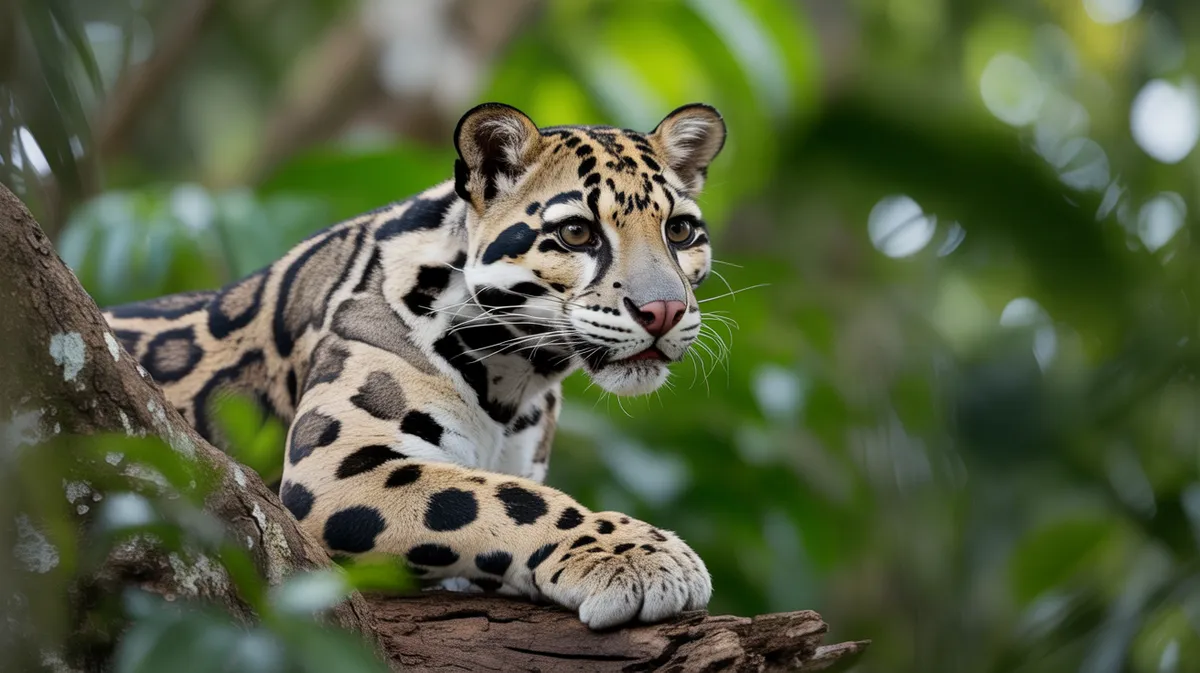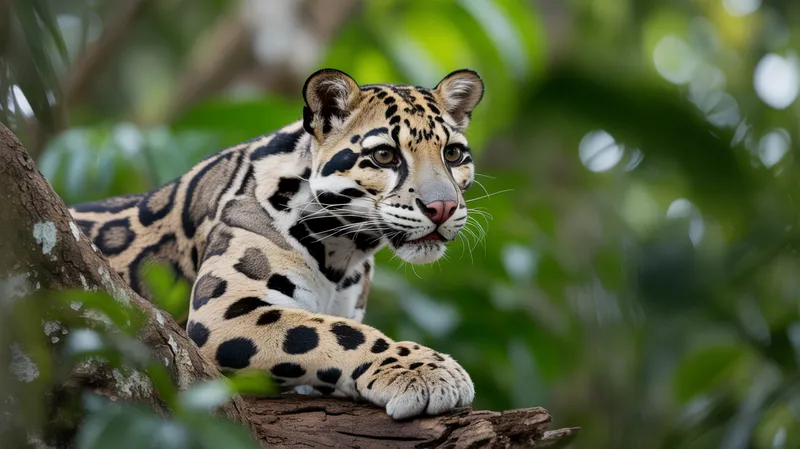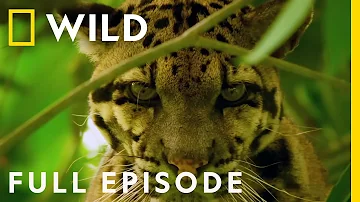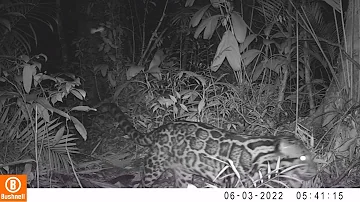
Sunda Clouded Leopard
Neofelis diardi

Meet the Sunda Clouded Leopard
The Sunda Clouded Leopard is a medium-sized wild cat native to the islands of Borneo and Sumatra in Southeast Asia. Characterized by its striking large, irregular 'cloud-like' spots, this elusive feline is superbly adapted for life in dense tropical forests. It is arboreal, spending much of its time climbing trees, and possesses notably long canine teeth and a powerful build for its size. The species is threatened by habitat loss and fragmentation, as well as illegal poaching. Due to its secretive nature and remote habitat, much about its behavior and ecology remains a mystery.
Classification
Mammal
Habitat
Tropical rainforest
Diet
Carnivore
Lifespan
11-17 years
Conservation
Vulnerable
Weight
12-26 kg
📖Fascinating Facts
Expert Tree Climber
The Sunda Clouded Leopard's short, flexible legs and large paws allow it to expertly climb and navigate through the forest canopy.
Distinctive Markings
Its name comes from the unique, cloud-shaped markings on its fur, which provide excellent camouflage in dappled jungle light.
Saber-like Canines
Their canines are proportionally the longest of any modern cat, reminiscent of extinct saber-toothed cats.
📋Detailed Description
The Sunda clouded leopard (Neofelis diardi) is a medium-sized felid distinguished by its robust build, elongated body, and relatively short legs, adapted for an arboreal lifestyle. Adults typically weigh between 12 and 26 kg, with males generally larger than females, and measure 55–110 cm in body length, with a thick, bushy tail nearly as long as the body itself, aiding in balance when navigating treetops. Its dense, soft fur is marked by large, irregular, cloud-shaped blotches edged in black, set against a background ranging from grayish to dark ochre, with the Bornean subspecies (N. d. borneensis) often showing darker coloration and smaller cloud patterns compared to the Sumatran form (N. d. diardi). The species possesses proportionally the longest upper canine teeth of any living felid, reminiscent of extinct saber-toothed cats, which are hypothesized to assist in delivering precise, fatal bites to prey. Sunda clouded leopards are highly secretive and primarily nocturnal, with activity peaking during twilight and nighttime hours. They are solitary outside of the breeding season, occupying large, overlapping home ranges in lowland and montane tropical forests, peat swamps, and occasionally logged or secondary forests. Their arboreal prowess is exceptional, with flexible ankle joints that allow them to descend trees headfirst and leap between branches. Despite their climbing abilities, they also travel and hunt on the ground. The species is an apex predator in its ecosystem, preying on a variety of vertebrates, and plays a crucial role in maintaining forest health. Due to their elusive nature and the dense habitats they occupy, many aspects of their ecology and population dynamics remain poorly understood.
💡 Did you know?
The Sunda Clouded Leopard was only recognized as a separate species from the mainland clouded leopard (Neofelis nebulosa) in 2006, based on molecular and morphological differences.
🔬Research & Sources
Wikipedia Summary
The Sunda clouded leopard is a medium-sized wild cat native to Borneo and Sumatra. It is listed as Vulnerable on the IUCN Red List since 2015, as the total effective population probably consists of fewer than 10,000 mature individuals, with a decreasing population trend. On both Sunda Islands, it is threatened by deforestation. It was classified as a separate species, distinct from its close relative, the clouded leopard in mainland Southeast Asia based on a study in 2006. Its fur is darker with a smaller cloud pattern.
Last Modified: 3/12/2025
🎭Behavior & Social Structure
Sunda clouded leopards are predominantly solitary and territorial, marking their ranges with scent and scratch marks. They are crepuscular to nocturnal, with camera trap studies indicating peak activity between dusk and dawn. Their hunting strategy combines stealth and ambush, utilizing dense vegetation and arboreal routes to approach prey undetected. Diet includes primates (such as macaques and gibbons), small ungulates (muntjac, mouse deer), birds, and occasionally domestic animals near forest edges. They are adept climbers, often resting or feeding in trees, but also hunt on the ground. Social interactions are rare outside of mating, and individuals avoid direct encounters through spatial and temporal separation. Communication is primarily olfactory, with vocalizations such as growls, hisses, and chuffing used in close-range interactions. Daily routines involve extensive patrolling of their territory, interspersed with periods of rest in concealed locations, often high in the forest canopy.
👶Reproduction & Life Cycle
Reproductive behavior in the wild is not well documented, but captive observations indicate a polygynous mating system. Breeding can occur year-round, though some evidence suggests peaks during the wet season. After a gestation period of approximately 90–102 days, females give birth to litters of 1–3 cubs, typically in a secluded den such as a hollow tree or dense thicket. Cubs are born blind and helpless, opening their eyes at around 10–14 days. The mother provides sole parental care, nursing and protecting the cubs for several months. Weaning occurs at 3–5 months, but juveniles may remain with their mother for up to 10 months before dispersing to establish their own territories. Sexual maturity is reached at around 2 years of age.
🛡️Adaptations & Survival
The Sunda clouded leopard exhibits several remarkable adaptations for an arboreal, predatory lifestyle. Its flexible ankle joints and rotating hind feet allow for agile climbing, descending, and maneuvering along branches. The long, bushy tail provides balance during leaps and rapid movement in the canopy. Exceptionally long canine teeth enable the cat to deliver deep, fatal bites to prey, even through thick fur or feathers. Retractable claws and strong forelimbs aid in grasping and subduing prey, as well as climbing. Cryptic coloration and cloud-like markings provide camouflage in dappled forest light, reducing detection by both prey and potential threats. Acute night vision and sensitive hearing further enhance its nocturnal hunting efficiency.
📚Research Sources
🎨Cultural Significance
The Sunda clouded leopard is rarely depicted in local folklore or mythology, likely due to its elusive nature. However, in some indigenous Dayak and Sumatran cultures, large cats are respected as forest spirits or omens, and their presence is considered a sign of a healthy forest. There are occasional reports of traditional use of skins or teeth as status symbols or for ritual purposes, but such practices are now rare and discouraged by conservation efforts. The species has become a flagship for rainforest conservation campaigns in Borneo and Sumatra, symbolizing the urgent need to protect Southeast Asia’s remaining forests.
🔬Recent Research & Discoveries
Recent advances in molecular genetics (notably the 2006 study that split Neofelis diardi from N. nebulosa) have clarified the evolutionary history of the species, revealing deep genetic divergence between Bornean and Sumatran populations, now recognized as distinct subspecies. Camera trapping and radio telemetry studies have begun to shed light on home range size, habitat preferences, and activity patterns, though much remains unknown due to the animal’s rarity and secretive habits. Ongoing research focuses on population monitoring, genetic diversity, and the impacts of habitat fragmentation. Conservation programs increasingly use community engagement and habitat corridors to mitigate isolation and promote genetic flow between populations.
🎥Wildlife Videos

India's Wild Leopard (Full Episode) | Nat Geo Wild
Follow cameraman Sandesh Kadur into some of India's most isolated regions on his mission to discover the secretive lives of ...
Nat Geo Animals

Clouded Leopards: Modern Day Saber-Tooths
Special thanks to the Cincinnati Zoo. Subscribe for new episodes every other Friday: http://bit.ly/SubscribeToAnimalogic ...
Animalogic

Sunda clouded leopard video
Clouded leopards are named for the cloud-like patterns on their coats, and this one is a beauty! This sleek big cat was videod by ...
The Orangutan Project

The Enigmatic Sunda Clouded Leopard A Deep Dive
The Sunda Clouded Leopard (*Neofelis diardi*) is a captivating and elusive predator native to the dense rainforests of Borneo ...
Exploring Animal & Nature

Clouded Leopard: Capturing one of the World's Rarest Cats (S02E05) | SZtv
The elusive and beautiful Sunda clouded leopard is one of the rarest cats in the whole world. Alex joins DGFC carnivore experts ...
SZtv

Sunda Clouded Leopard (Neofelis diardi)
This is a rare spotting (pun intended) of the magnificent Sunda clouded leopard, named for the Sunda Islands and for the pattern ...
Saving Nature
🌍Habitat Information
The Sunda Clouded Leopard typically inhabits Tropical rainforest environments. Sunda Clouded Leopards have adapted to their environments with specialized features and behaviors.
Primary Habitat:
Tropical rainforest
More detailed habitat information will be available soon.
🛡️Conservation Status
The Sunda Clouded Leopard is currently classified as Vulnerable. Conservation efforts are crucial for preserving this species for future generations.
Common Threats:
- 🏠Habitat loss and fragmentation
- 🌡️Climate change impacts
- 🎯Hunting and poaching
- 🏭Human-wildlife conflict
⚠️Threats & Conservation Challenges
The primary threat to the Sunda clouded leopard is large-scale deforestation for palm oil plantations, logging, and agricultural expansion, leading to habitat loss, fragmentation, and population isolation. Poaching for the illegal wildlife trade, including skins, bones, and teeth, poses a significant risk, despite legal protection under CITES Appendix I. Road construction and human encroachment increase mortality from vehicle collisions and conflict with humans. The species' low population density, secretive habits, and large home range requirements make it particularly vulnerable to environmental changes. Population estimates suggest fewer than 10,000 mature individuals remain, with a declining trend due to ongoing habitat degradation and insufficient law enforcement.
🔬Scientific Classification
Scientific Name
Neofelis diardi
Classification Hierarchy
🔍 About Taxonomic Classification
Taxonomic classification is a hierarchical system used by scientists to classify and organize living organisms based on shared characteristics and evolutionary relationships.
The system moves from broad categories (Kingdom) to increasingly specific ones, with each animal's scientific name typically consisting of its Genus and species.
📝Community Notes
Share your observations and insights about the Sunda Clouded Leopard with our community of wildlife enthusiasts.
Join Our Community
Sign in to share your observations and connect with fellow wildlife enthusiasts.
Sign In to ContributeNo community notes yet
Be the first to share your observations about the Sunda Clouded Leopard!
Explore Sunda Clouded Leopard
Select a tab above to learn more about this amazing animal.
📸Photo Gallery
No photos available for this animal yet.
🌟Discover More Wildlife
Continue your journey of discovery with more fascinating animals from our database
